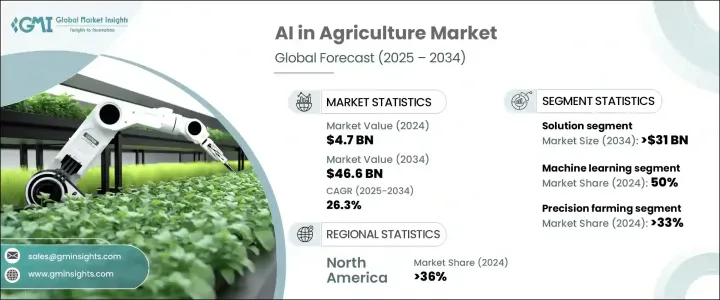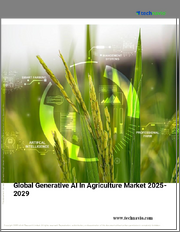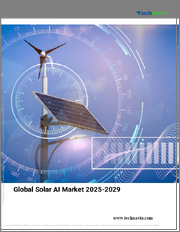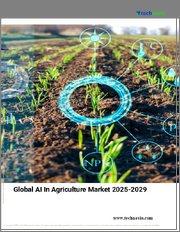
|
시장보고서
상품코드
1750546
세계의 농업용 AI 시장 : 기회, 성장 촉진요인, 산업 동향 분석 및 예측(2025-2034년)AI in Agriculture Market Opportunity, Growth Drivers, Industry Trend Analysis, and Forecast 2025 - 2034 |
||||||
세계의 농업용 AI 시장은 2024년 47억 달러로 평가되었고 농업 생산성 향상, 자원 이용 최적화, 농업 노동력 부족 대처를 목적으로 한 AI 기술의 채택 증가로 2034년에는 466억 달러에 달할 것으로 예측되며, CAGR 26.3%로 성장할 전망입니다.
머신러닝 알고리즘, 예측 분석, 자동화 등 AI 응용 기술은 작물 모니터링, 질병 탐지, 관개 관리, 수확량 예측 등을 개선하기 위해 활용되고 있습니다.

AI 기술은 농민들이 방대한 데이터셋에서 실시간 인사이트를 활용할 수 있도록 지원하여 자원 활용 최적화, 작물 손실 최소화, 전체 수확량 품질 향상을 돕습니다. 이 정밀한 접근 방식은 운영 효율성을 개선하는 동시에 표적 관개, 예측 해충 관리, 토양 건강 모니터링과 같은 지속 가능한 농업 방법을 촉진합니다. AI를 일상적인 농장 운영에 통합함으로써 생산자는 문제를 예측하고, 낭비를 줄이며, 환경 변화에 신속하게 대응할 수 있습니다. 이는 자원이 제한된 세계에서 증가하는 식량 수요를 충족하는 데 필수적인 요소입니다.
| 시장 범위 | |
|---|---|
| 시작 연도 | 2024년 |
| 예측 연도 | 2025년-2034년 |
| 시작금액 | 47억 달러 |
| 예측 금액 | 466억 달러 |
| CAGR | 26.3% |
솔루션 부문은 2024년에 시장을 지배하며 33억 달러를 창출했으며, 2034년에는 310억 달러에 달할 것으로 예상됩니다. AI 기반 솔루션은 작물 모니터링, 질병 감지, 정밀 심기, 지능형 관개, 수확량 예측 등 다양한 응용 분야를 포괄합니다. 이 소프트웨어 플랫폼은 센서, 드론, 위성 이미징에서 수집된 데이터를 분석하여 농민에게 실행 가능한 통찰력을 제공합니다. AI 솔루션의 확장성과 유연성은 다양한 작물, 지역, 농업 방식에 적용 가능하며, 개별 서비스에 비해 비용 효율성과 효과성을 높입니다. 대부분의 AI 농업 솔루션은 클라우드 기반이며 사용자 친화적이어서 모든 규모의 농장에서 쉽게 구현할 수 있습니다.
머신러닝(ML)은 2024년에 50%의 상당한 시장 점유율을 차지했으며, 상당한 성장이 예상됩니다. ML 알고리즘은 농업에서 대량의 구조화 및 비구조화 데이터를 처리하는 데 탁월하여 정확한 예측을 가능하게 합니다. ML은 수확량 예측, 질병 탐지 및 해충 감염 예측에 광범위하게 적용됩니다. 이러한 모델은 새로운 데이터가 축적될수록 시간이 지남에 따라 개선되어 ML을 AI 기반의 다양한 농업 솔루션을 뒷받침하는 다목적 기술로 만듭니다. 지능형 관개, 정밀 농업, 시장 예측, 자동화 기계 등에 이르기까지 대부분의 AI 시스템은 ML 알고리즘에 의존하여 실시간 데이터 스트림을 기반으로 한 실시간 의사결정을 가능하게 합니다.
북미의 농업용 AI 시장은 2024년 36%의 시장 점유율을 차지했습니다. 미국은 기술 혁신의 글로벌 리더로, 특히 인공지능과 정밀 농업 분야에서 선도적인 역할을 하고 있습니다. 주요 기술 기업들은 농업 생산성 솔루션을 개발하기 위해 AI 및 기계 학습에 투자하고 있습니다. 또한 미국은 대학과 정부 프로그램이 농업 기술의 발전을 촉진하는 강력한 연구 개발 생태계를 자랑합니다. 이러한 요인들이 높은 투자와 역량과 결합되어 미국은 농업용 AI 응용 분야의 선두에 서며 글로벌 시장에서 리더십을 강화하고 있습니다.
농업용 AI 시장에서 활동하는 주요 기업으로는 Gamaya, Corteva, John Deere, Taranis, aWhere, Trimble, IBM, Microsoft 및 Bayer Crop Science (Climate LLC) 등이 있습니다. 이 기업들은 농업 관행을 개선하고 농업 산업이 직면한 과제를 해결하기 위해 AI 기반 솔루션을 적극적으로 개발 및 배포하고 있습니다. 농업용 AI 시장에서 입지를 강화하기 위해 기업들은 여러 가지 전략적 이니셔티브에 집중하고 있습니다. 여기에는 농부들의 특정 요구에 맞는 혁신적인 AI 솔루션을 개발하기 위한 연구 개발에 대한 투자가 포함됩니다. 식량 안보, 지속 가능성, 기후 변화와 같은 광범위한 과제를 해결하기 위한 AI 기반 솔루션을 개발하고 구현하기 위해 농업 기관, 연구 기관 및 정부 기관과의 협력 및 파트너십이 추진되고 있습니다. 새로운 시장에 진출하고 주요 지역에 입지를 구축하여 글로벌 입지를 확대하는 것도 더 큰 시장 점유율을 확보하기 위한 또 다른 전략입니다.
목차
제1장 조사 방법과 범위
제2장 주요 요약
제3장 업계 인사이트
- 업계 생태계 분석
- 공급자의 상황
- 기술 공급업체
- 농업 기술 기기 제조업체
- 농작물 투입 자재 회사
- IoT 센서 및 이미지 솔루션 제공업체
- 농업 기술 스타트업 및 데이터 통합업체
- 이익률 분석
- 공급자의 상황
- 트럼프 정권에 의한 관세에 대한 영향
- 무역에 미치는 영향
- 무역량의 혼란
- 보복 조치
- 업계에 미치는 영향
- 주요 원자재의 가격 변동
- 공급망 재구성
- 최종 시장에의 가격 전달
- 전략적인 업계 대응
- 공급망 재구성
- 가격 설정 및 제품 전략
- 무역에 미치는 영향
- 기술과 혁신의 상황
- 주요 뉴스와 대처
- 코스트 내역 분석
- 가격 분석
- 제품
- 지역
- 특허 분석
- 규제 상황
- 영향요인
- 성장 촉진요인
- 정밀 농업에 대한 수요 증가
- 노동력 부족 및 자동화 필요성
- 정부 정책 및 자금 지원
- 기후 변화 및 위험 완화 필요성
- 업계의 잠재적 리스크 및 과제
- AI 기술 구현에 필요한 높은 초기 비용
- 인프라와 연결성 부족
- 성장 촉진요인
- 성장 가능성 분석
- Porter's Five Forces 분석
- PESTEL 분석
제4장 경쟁 구도
- 소개
- 기업의 시장 점유율 분석
- 경쟁 포지셔닝 매트릭스
- 전략적 전망 매트릭스
제5장 시장 추계 및 예측 : 컴포넌트별(2021-2034년)
- 주요 동향
- 솔루션
- 서비스
제6장 시장 추계 및 예측 : 기술별(2021-2034년)
- 주요 동향
- 머신러닝
- 컴퓨터 비전
- 예측 분석
제7장 시장 추계 및 예측 : 용도별(2021-2034년)
- 주요 동향
- 작물 및 토양 모니터링
- 가축 건강 모니터링
- 지능형 스프레이
- 정밀 농업
- 농업 로봇
- 날씨 데이터 및 예보
- 기타
제8장 시장 추계 및 예측 : 전개 모드별(2021-2034년)
- 주요 동향
- 클라우드 기반
- 온프레미스
제9장 시장 추계 및 예측 : 농장 규모별(2021-2034년)
- 주요 동향
- 소규모 농장
- 중규모 농장
- 대규모 농장
제10장 시장 추계 및 예측 : 지역별(2021-2034년)
- 주요 동향
- 북미
- 미국
- 캐나다
- 유럽
- 영국
- 독일
- 프랑스
- 이탈리아
- 스페인
- 러시아
- 북유럽 국가
- 아시아태평양
- 중국
- 인도
- 일본
- 한국
- 호주
- 동남아시아
- 라틴아메리카
- 브라질
- 멕시코
- 아르헨티나
- 중동 및 아프리카
- 아랍에미리트(UAE)
- 사우디아라비아
- 남아프리카
제11장 기업 프로파일
- AWhere
- Bayer Crop Science(Climate LLC)
- Benson Hill Biosystems
- Blue River Technology
- Bluewhite
- Carbon Robotics
- Corteva Agriscience
- Cropin
- ec2ce
- Ever.Ag(includes Cainthus Corp)
- FarmWise
- Gamaya
- Hippo Harvest
- IBM
- John Deere
- Microsoft
- Taranis
- Trimble
- Tule Technologies
- Valmont Industries(Prospera Technologies)
The Global AI in Agriculture Market was valued at USD 4.7 billion in 2024 and is estimated to grow at a CAGR of 26.3% to reach USD 46.6 billion by 2034, driven by the increasing adoption of AI technologies to enhance agricultural productivity, optimize resource utilization, and address labor shortages in farming. AI applications, such as machine learning algorithms, predictive analytics, and automation, are being utilized to improve crop monitoring, disease detection, irrigation management, and yield forecasting.

AI technologies empower farmers to harness real-time insights from vast datasets, helping them optimize resource use, minimize crop losses, and enhance overall yield quality. This precision-driven approach improves operational efficiency while promoting sustainable agricultural methods, such as targeted irrigation, predictive pest management, and soil health monitoring. By integrating AI into everyday farm operations, producers can anticipate challenges, reduce waste, and respond quickly to environmental changes-all essential in meeting the growing global demand for food in a resource-constrained world.
| Market Scope | |
|---|---|
| Start Year | 2024 |
| Forecast Year | 2025-2034 |
| Start Value | $4.7 Billion |
| Forecast Value | $46.6 Billion |
| CAGR | 26.3% |
The solution segment dominated the market in 2024, generated USD 3.3 billion, and is projected to reach USD 31 billion by 2034. AI-based solutions encompass a wide range of applications, including crop monitoring, disease detection, precision planting, intelligent irrigation, and yield forecasting. These software platforms analyze data from sensors, drones, and satellite imaging to provide farmers with actionable insights. The scalability and flexibility of AI solutions make them applicable across various crops, geographies, and farming practices, enhancing their affordability and effectiveness compared to individual services. Most AI agricultural solutions are cloud-based and user-friendly, facilitating easy implementation on farms of any size.
Machine learning (ML) held a significant market share of 50% in 2024 and is expected to experience substantial growth. ML algorithms excel at processing large volumes of structured and unstructured data in agriculture, enabling accurate predictions. ML is extensively applied in yield prediction, disease detection, and pest infestation forecasting. These models improve over time as new data is accumulated, making ML a versatile technology that underpins many AI-driven agricultural solutions. From intelligent irrigation and precision farming to market forecasting and automated machinery, most AI systems rely on ML algorithms, enabling real-time decision-making based on live and historical data streams.
North America AI in Agriculture Market held a 36% share in 2024. The U.S. is a global leader in technological innovation, particularly in artificial intelligence and precision agriculture. Major technology firms have invested in AI and machine learning to develop agricultural productivity solutions. The country also boasts a strong research and development ecosystem, with universities and government programs driving agri-tech advancements. These factors, combined with high investments and capabilities, position the U.S. at the forefront of AI applications in agriculture, facilitating its leadership in the global market.
Key players operating in the AI in Agriculture Market include: Gamaya, Corteva, John Deere, Taranis, aWhere, Trimble, IBM, Microsoft, and Bayer Crop Science (Climate LLC). These companies are actively developing and deploying AI-driven solutions to enhance agricultural practices and address the challenges faced by the farming industry. To strengthen their presence in the AI in agriculture market, companies are focusing on several strategic initiatives. These include investing in research and development to create innovative AI solutions tailored to the specific needs of farmers. Collaborations and partnerships with agricultural organizations, research institutions, and government agencies are being pursued to develop and implement AI-driven solutions that address broader challenges such as food security, sustainability, and climate change. Expanding their global footprint by entering new markets and establishing a presence in key regions is another strategy to capture a larger market share.
Table of Contents
Chapter 1 Methodology & Scope
- 1.1 Research design
- 1.1.1 Research approach
- 1.1.2 Data collection methods
- 1.2 Base estimates and calculations
- 1.2.1 Base year calculation
- 1.2.2 Key trends for market estimates
- 1.3 Forecast model
- 1.4 Primary research & validation
- 1.4.1 Primary sources
- 1.4.2 Data mining sources
- 1.5 Market definitions
Chapter 2 Executive Summary
- 2.1 Industry 3600 synopsis, 2021 - 2034
Chapter 3 Industry Insights
- 3.1 Industry ecosystem analysis
- 3.1.1 Supplier landscape
- 3.1.1.1 Technology providers
- 3.1.1.2 Agri-tech equipment manufacturers
- 3.1.1.3 Crop input companies
- 3.1.1.4 IOT sensors and image solution providers
- 3.1.1.5 Agri-tech startups and data integrators
- 3.1.2 Profit margin analysis
- 3.1.1 Supplier landscape
- 3.2 Impact of Trump administration tariffs
- 3.2.1 Impact on trade
- 3.2.1.1 Trade volume disruptions
- 3.2.1.2 Retaliatory measures
- 3.2.2 Impact on the Industry
- 3.2.2.1 Price volatility in key materials
- 3.2.2.2 Supply chain restructuring
- 3.2.2.3 Price transmission to end markets
- 3.2.3 Strategic industry responses
- 3.2.3.1 Supply chain reconfiguration
- 3.2.3.2 Pricing and product strategies
- 3.2.1 Impact on trade
- 3.3 Technology & innovation landscape
- 3.4 Key news & initiatives
- 3.5 Cost breakdown analysis
- 3.6 Pricing analysis
- 3.6.1 Product
- 3.6.2 Region
- 3.7 Patent analysis
- 3.8 Regulatory landscape
- 3.9 Impact forces
- 3.9.1 Growth drivers
- 3.9.1.1 Rising demand for precision farming
- 3.9.1.2 Labor shortages and need for automation
- 3.9.1.3 Government initiatives and funding support
- 3.9.1.4 Climate change and the need for risk mitigation
- 3.9.2 Industry pitfalls & challenges
- 3.9.2.1 High initial cost of implementing AI technologies
- 3.9.2.2 Lack of infrastructure and connectivity
- 3.9.1 Growth drivers
- 3.10 Growth potential analysis
- 3.11 Porter's analysis
- 3.12 PESTEL analysis
Chapter 4 Competitive Landscape, 2024
- 4.1 Introduction
- 4.2 Company market share analysis
- 4.3 Competitive positioning matrix
- 4.4 Strategic outlook matrix
Chapter 5 Market Estimates & Forecast, By Component, 2021 - 2034 ($Mn)
- 5.1 Key trends
- 5.2 Solution
- 5.3 Service
Chapter 6 Market Estimates & Forecast, By Technology, 2021 - 2034 ($Mn)
- 6.1 Key trends
- 6.2 Machine learning
- 6.3 Computer vision
- 6.4 Predictive analysis
Chapter 7 Market Estimates & Forecast, By Application, 2021 - 2034 ($Mn)
- 7.1 Key trends
- 7.2 Crop and soil monitoring
- 7.3 Livestock health monitoring
- 7.4 Intelligent spraying
- 7.5 Precision farming
- 7.6 Agriculture robot
- 7.7 Weather data and forecast
- 7.8 Others
Chapter 8 Market Estimates & Forecast, By Deployment mode, 2021 - 2034 ($Mn)
- 8.1 Key trends
- 8.2 Cloud-based
- 8.3 On-premises
Chapter 9 Market Estimates & Forecast, By Farm Size, 2021 - 2034 ($Mn)
- 9.1 Key trends
- 9.2 Small farm
- 9.3 Mid-sized farm
- 9.4 Large farm
Chapter 10 Market Estimates & Forecast, By Region, 2021 - 2034 ($Mn, Units)
- 10.1 Key trends
- 10.2 North America
- 10.2.1 U.S.
- 10.2.2 Canada
- 10.3 Europe
- 10.3.1 UK
- 10.3.2 Germany
- 10.3.3 France
- 10.3.4 Italy
- 10.3.5 Spain
- 10.3.6 Russia
- 10.3.7 Nordics
- 10.4 Asia Pacific
- 10.4.1 China
- 10.4.2 India
- 10.4.3 Japan
- 10.4.4 South Korea
- 10.4.5 Australia
- 10.4.6 Southeast Asia
- 10.5 Latin America
- 10.5.1 Brazil
- 10.5.2 Mexico
- 10.5.3 Argentina
- 10.6 MEA
- 10.6.1 UAE
- 10.6.2 Saudi Arabia
- 10.6.3 South Africa
Chapter 11 Company Profiles
- 11.1 AWhere
- 11.2 Bayer Crop Science (Climate LLC)
- 11.3 Benson Hill Biosystems
- 11.4 Blue River Technology
- 11.5 Bluewhite
- 11.6 Carbon Robotics
- 11.7 Corteva Agriscience
- 11.8 Cropin
- 11.9 ec2ce
- 11.10 Ever.Ag (includes Cainthus Corp)
- 11.11 FarmWise
- 11.12 Gamaya
- 11.13 Hippo Harvest
- 11.14 IBM
- 11.15 John Deere
- 11.16 Microsoft
- 11.17 Taranis
- 11.18 Trimble
- 11.19 Tule Technologies
- 11.20 Valmont Industries (Prospera Technologies)



















